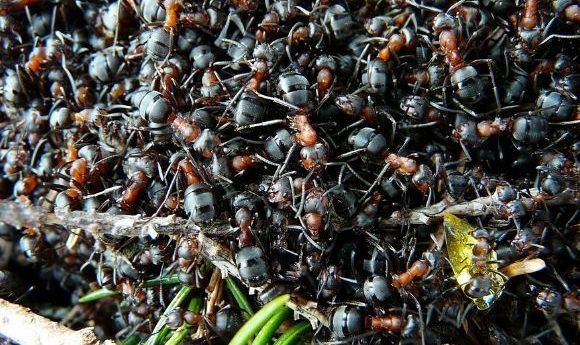Cannibalistic ant colony escapes soviet war bunker

An ant colony that survived for years in post-soviet nuclear weapon bunker by turning to cannibalism, has been assisted to freedom.
Researchers have successfully evacuated a wood ant colony, of the species Formica polyctena, from a post-soviet nuclear weapon bunker in Poland. The colony was discovered in 2013, during the annual search for hibernating bats.
In the original paper, published in the Journal of Hymenoptera Research in 2016, the researchers described a colony of nearly one million worker ants that originated from a large nest outdoors, on top of the bunker’s ventilation pipe.
The researchers assumed the ants dropped through the pipe to the bunker but were unable to reach the outlet to escape back to the nest. Despite being trapped with no heat, light or obvious food supply, the colony was still thriving several years after discovery.
In the present study, published again in the Journal of Hymenoptera Research, the researchers reported their successful attempt at evacuating the colony using an experimentally installed boardwalk, that allowed the ants to reach the outlet and return to their nest.
- Ants: models for epidemic spread
- Could hibernation help to reduce obesity?
- The ancient canine cancer that has spread worldwide
Initially, the researchers released a group of around 100 ants from the bunker to the area around the observed nest, to confirm the relation between the two groups. As no aggressive behavior was observed, the group, led by Wojciech Czechowski (Polish Academy of Science, Warsaw, Poland), began to work on freeing the ant colony.
The team constructed a 3-meter-long boardwalk with one end burrowed in a mound, fully inhabited by ant workers, and the other inside of the ventilation pipe. This acted as an escape route for the ant colony and would allow them to reach the mother nest.
Almost immediately, the ants started to investigate the boardwalk and within 6 months the bunker was essentially deserted. As the maternal nest is still located above the bunker’s ventilation pipe, ants continue to fall down into the bunker but are now able to escape.
As well as freeing the ant colony, the researchers made an important discovery about how the ant colony survived for years in the bunker with no obvious source of food. By analyzing corpses of the ants, the researchers deduced that the colony survived by consuming the corpses of their nestmates.
“The present case adds a dimension to the great adaptive ability of ants to marginal habitats and suboptimal conditions, as the key to understanding their unquestionable eco-evolutionary success,” the authors concluded.